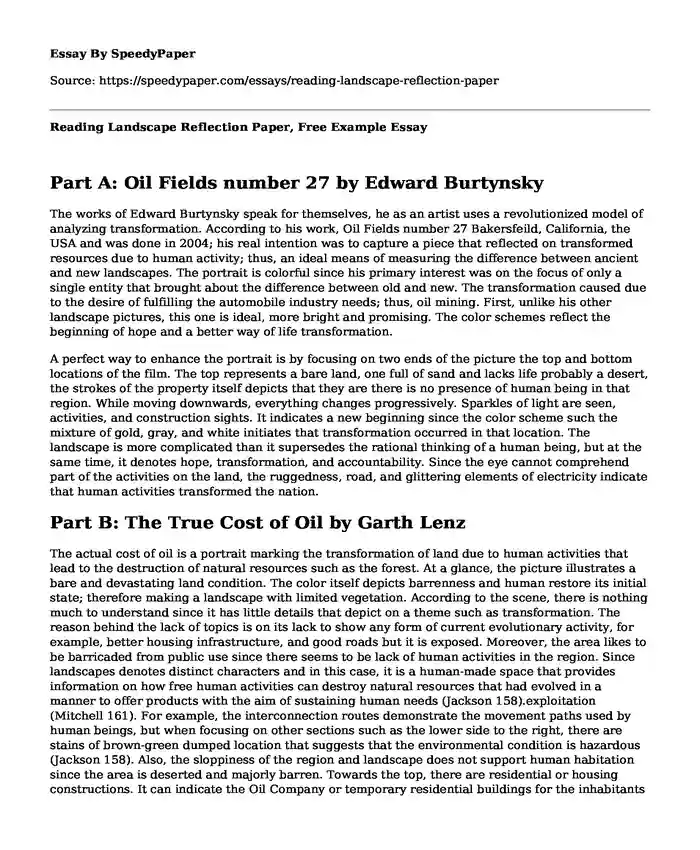Part A: Oil Fields number 27 by Edward Burtynsky
The works of Edward Burtynsky speak for themselves, he as an artist uses a revolutionized model of analyzing transformation. According to his work, Oil Fields number 27 Bakersfeild, California, the USA and was done in 2004; his real intention was to capture a piece that reflected on transformed resources due to human activity; thus, an ideal means of measuring the difference between ancient and new landscapes. The portrait is colorful since his primary interest was on the focus of only a single entity that brought about the difference between old and new. The transformation caused due to the desire of fulfilling the automobile industry needs; thus, oil mining. First, unlike his other landscape pictures, this one is ideal, more bright and promising. The color schemes reflect the beginning of hope and a better way of life transformation.
A perfect way to enhance the portrait is by focusing on two ends of the picture the top and bottom locations of the film. The top represents a bare land, one full of sand and lacks life probably a desert, the strokes of the property itself depicts that they are there is no presence of human being in that region. While moving downwards, everything changes progressively. Sparkles of light are seen, activities, and construction sights. It indicates a new beginning since the color scheme such the mixture of gold, gray, and white initiates that transformation occurred in that location. The landscape is more complicated than it supersedes the rational thinking of a human being, but at the same time, it denotes hope, transformation, and accountability. Since the eye cannot comprehend part of the activities on the land, the ruggedness, road, and glittering elements of electricity indicate that human activities transformed the nation.
Part B: The True Cost of Oil by Garth Lenz
The actual cost of oil is a portrait marking the transformation of land due to human activities that lead to the destruction of natural resources such as the forest. At a glance, the picture illustrates a bare and devastating land condition. The color itself depicts barrenness and human restore its initial state; therefore making a landscape with limited vegetation. According to the scene, there is nothing much to understand since it has little details that depict on a theme such as transformation. The reason behind the lack of topics is on its lack to show any form of current evolutionary activity, for example, better housing infrastructure, and good roads but it is exposed. Moreover, the area likes to be barricaded from public use since there seems to be lack of human activities in the region. Since landscapes denotes distinct characters and in this case, it is a human-made space that provides information on how free human activities can destroy natural resources that had evolved in a manner to offer products with the aim of sustaining human needs (Jackson 158).exploitation (Mitchell 161). For example, the interconnection routes demonstrate the movement paths used by human beings, but when focusing on other sections such as the lower side to the right, there are stains of brown-green dumped location that suggests that the environmental condition is hazardous (Jackson 158). Also, the sloppiness of the region and landscape does not support human habitation since the area is deserted and majorly barren. Towards the top, there are residential or housing constructions. It can indicate the Oil Company or temporary residential buildings for the inhabitants of this region.
Rocky fields surround the area, and fluid type element and the interconnection between the roads enhance the aspect of the large stable production of the raw material. With the large mining production, the fields had limited time to
Work Cited
Jackson, John Brinckerhoff. "The World Itself" From Discovering the Vernacular Landscape." (1984): 153-158.
Mitchell, Don. "Califonia: The Beautiful and the Damned" from the lie of the land: Migrant Workers and the California Landscape." (1996): 159-164.
Cite this page
Reading Landscape Reflection Paper, Free Example. (2022, Sep 08). Retrieved from https://speedypaper.net/essays/reading-landscape-reflection-paper
Request Removal
If you are the original author of this essay and no longer wish to have it published on the SpeedyPaper website, please click below to request its removal:
- HRM Essay Sample on Hiring, Recruitment and Job Analysis
- Free Essay Sample on Debate between Mishra and Ferguson
- Description of Stock Character Types in One Tree Hill. Essay Sample on Teen Movies.
- Starbucks Corporation's WACC, Essay Sample for Students
- California Sexual Assault Politics, Essay Example for Free
- Essay Sample on Cultural Anthropology: Kosher Chinese
- Paper Example. Assault Performance Task
Popular categories





